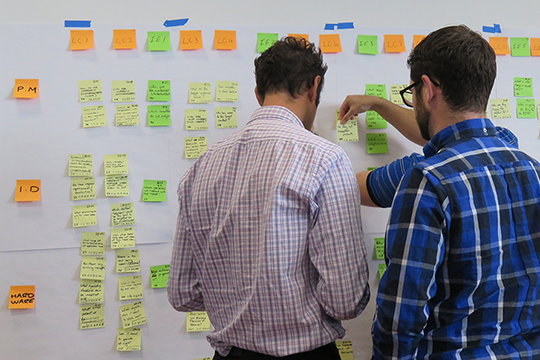In early March of 2020, I had to send out final notices postponing all the Rapid Learning Cycles Program Manager workshops we had on the calendar for spring — a scary thing, since this is our primary source of revenue.
This was definitely a Key Decision for us — high impact and high unknown, with many Knowledge Gaps, some of which could never be closed because they are unknowable.
Yet we were at the Last Responsible Moment to make this decision, as it was time to start producing materials, booking travel and making commitments to venues.
Many people within my community were being forced to make decisions like this in their professional and personal lives to deal with the many disruptions caused by the pandemic. Fortunately, many of them have had practice with managing uncertainty through the Rapid Learning Cycles framework (RLCs).
The lessons of RLCs are especially relevant in times of high uncertainty.
If you have been using or at least experimenting with RLCs, then you’ve seen how we focus on identifying the Key Decisions (high impact / high unknown decisions), and then taking steps to make those decisions at the right time, with the right people, and the best available knowledge. We pull the learning forward on Key Decisions, while delaying the decisions themselves to allow more time for more knowledge to emerge.
You may have a lot of Key Decisions right now, in your professional and personal lives, around what to do about your in-flight projects, and what actions to take to protect yourself and your loved ones.
Some of the things you’d like to know about these decisions, such as when will it be safe to go back into the office or to visit that supplier, may be unknowable right now. Other things are changing rapidly, such as what businesses have been able to remain open.
Treat these major decisions as Key Decisions to manage the uncertainty.
I encourage you to treat them as Key Decisions:
- Clarify the decision to be made.
- Write the decision in the form of a sharp, clear question that emphasizes your CHOICE: What will I do? What will we do?
- Think through who needs to be involved in making the decision, who would be impacted, and who needs to be informed.
- Determine the Last Responsible Moment when you can make this decision — the last point in time when you can make the decision while minimizing impact on others.
- Identify the Knowledge Gaps that you’d ideally like to have closed in order to make this decision with confidence.
Recognize that not all Knowledge Gaps can be closed, but at least you’ll know what risk you’re taking by not closing them. - Just taking these steps can help manage the uncertainty by making it clear where you can take action so that you can focus there, while freeing up space to delay the decision until the Last Responsible Moment.
Manage Uncertainty by Delaying Key Decisions — And Making Other Ones
In a dynamic situation, a delayed decision is usually a better decision because you are able to make the decision with better information. But not every decision needs to be delayed or should be delayed.
The Last Responsible Moment is especially powerful in times of high uncertainty because you will be able to make a better decision at that time than you can right now. But if a decision is low impact, it can be easily changed or doesn’t matter. And if you already know what to do — and you’ve validated that you know as much as you think you do — then it’s probably a safe decision.
Key Decisions are by definition both high impact AND high unknown. Delaying a decision like this is giving yourself more time to learn what you can learn, and giving the situation more time to develop. But even for Key Decisions, the Last Responsible Moment is the last RESPONSIBLE moment, which is probably not the last minute.
The first workshop we needed to cancel was in Minneapolis, and was scheduled about ten days after we made the decision. I could have delayed the decision until it was time to actually get on the plane — the last minute. But that is not the Last Responsible Moment because that would have caused severe downstream impacts on my clients and workshop participants, my staff and the hotel that would have hosted us.
That would have created needless uncertainty and ambiguity for them, at a time when we all had too much of that.
Finally, dealing with so much uncertainty and ambiguity is hard work.
It’s tempting to make decisions just to eliminate some of the open loops. But in times like these, a wrong decision can make things much worse than they would have been with no decision at all. And Key Decisions are the ones we are most likely to get wrong when it counts, the ones most likely to lead to negative consequences when we make them too early.
Sometimes we can relieve the pressure by making the easy decisions in areas of low impact or where we do know with certainty what we need to know, and by deciding WHEN and HOW to decide the Key Decisions.
We can also pull learning forward, so that we’re taking action without making decisions that don’t need to be made right now.
All of that will bring much greater clarity about what you MUST do now, what you CAN do now, and what you need to delay in order to have a better outcome.
Take the actions you can, and delay the decisions you can.
At the Rapid Learning Cycles Institute, we’re working on the things we can do with our small, local team: improve our web site, work on developing more and better online offerings, reach out to people who may have more time on their hands now to learn about how we can help them.
Meanwhile, we’ve decided when to decide about rescheduling workshops and other work that requires travel, and how to know when we’re at the Last Responsible Moment to put a workshop on the calendar. That has helped reduce the uncertainty down to a manageable level.



